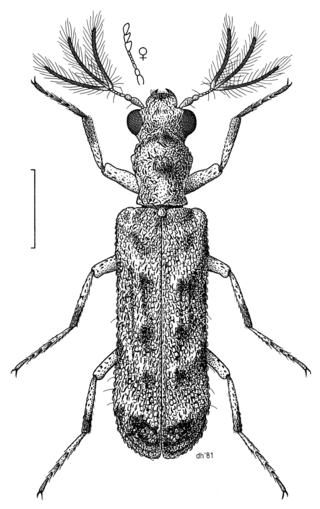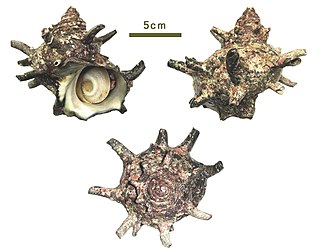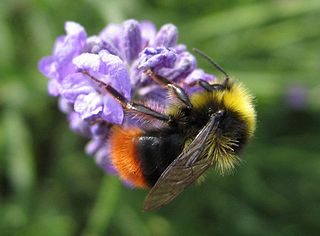
A bumblebee is any of over 250 species in the genus Bombus, part of Apidae, one of the bee families. This genus is the only extant group in the tribe Bombini, though a few extinct related genera are known from fossils. They are found primarily in higher altitudes or latitudes in the Northern Hemisphere, although they are also found in South America, where a few lowland tropical species have been identified. European bumblebees have also been introduced to New Zealand and Tasmania. Female bumblebees can sting repeatedly, but generally ignore humans and other animals.
Lucius Annaeus Cornutus, a Stoic philosopher, flourished in the reign of Nero, when his house in Rome was a school of philosophy.

Bombus terrestris, the buff-tailed bumblebee or large earth bumblebee, is one of the most numerous bumblebee species in Europe. It is one of the main species used in greenhouse pollination, and so can be found in many countries and areas where it is not native, such as Tasmania. Moreover, it is a eusocial insect with an overlap of generations, a division of labor, and cooperative brood care. The queen is monandrous which means she mates with only one male. B. terrestris workers learn flower colors and forage efficiently.

Bombus is a GPL instant messaging client for the XMPP protocol. It is written in Java, and runs on Java ME/MIDP capable cellphones, including Windows Mobile platform with installed Java ME virtual machine, or any other platform, where Java ME is available. There was successful compilations of Bombue for Android.

The term cuckoo bee is used for a variety of different bee lineages which have evolved the kleptoparasitic behaviour of laying their eggs in the nests of other bees, reminiscent of the behavior of cuckoo birds. The name is perhaps best applied to the apid subfamily Nomadinae, but is commonly used in Europe to mean bumblebees Bombus subgenus Psithyrus. Females of cuckoo bees are easy to recognize in almost all cases, as they lack pollen collecting structures and do not construct their own nests. They often have reduced body hair, abnormally thick and/or heavily sculptured exoskeleton, and saber-like mandibles, although this is not universally true; other less visible changes are also common.

The Bostrichidae are a family of beetles with more than 700 described species. They are commonly called auger beetles, false powderpost beetles, or horned powderpost beetles. The head of most auger beetles cannot be seen from above, as it is downwardly directed and hidden by the thorax. Exceptions are the powderpost beetles, and members of the subfamily Psoinae.

Cuckoo bumblebees are members of the subgenus Psithyrus in the bumblebee genus Bombus. Until recently, the 28 species of Psithyrus were considered to constitute a separate genus. They are a specialized socially parasitic lineage which parasitises the nests of 'true' bumblebees, resulting in the loss of the ability to collect pollen and establish their own nests. Cuckoo bumblebees do not create a worker caste and produce only male and female reproductives. They are considered inquilines in the colonies of 'true' bumblebees.

The early bumblebee or early-nesting bumblebee is a small bumblebee with a wide distribution in most of Europe and parts of Asia. It is very commonly found in the UK and emerges to begin its colony cycle as soon as February which is earlier than most other species, hence its common name. There is even some evidence that the early bumblebee may be able to go through two colony cycles in a year. Like other bumblebees, Bombus pratorum lives in colonies with queen and worker castes. Bombus pratorum queens use aggressive behavior rather than pheromones to maintain dominance over the workers!

Pteroplax is an extinct genus of embolomerous anthracosaur. Only one species has been described; the skull table noted is the lectotype of this species. Pteroplax dates from the late Carboniferous Period, about 315 million years ago. It is known with certainty only from Newsham in Blyth, Northumberland, England. At that site, it shared a coal-swamp lake habitat with the larger embolomere, "Eogyrinus". Pteroplax probably grew up to about 10 ft (3.0 m) in length and was largely aquatic, feeding upon fish and smaller tetrapods. It likely had a long, eel-like body, with short limbs and a long tail.
B. cornutus may refer to:
Gaius Julius Cornutus Tertullus was a Roman senator who was active during the late 1st and early 2nd centuries. He is best known as the older friend of Pliny the Younger, with whom Cornutus was suffect consul for the nundinium of September to October 100.

Alpigenobombus is a subgenus of the genus Bombus.

Bombus lucorum, the white-tailed bumblebee, is a species of bumblebee, widespread and common throughout Europe. This name has been widely used for a range of nearly identical-looking or cryptic species of bumblebees. In 1983, Scholl and Obrecht even coined the term Bombus lucorum complex to explain the three taxa that cannot be easily differentiated from one another by their appearances. A recent review of all of these species worldwide has helped to clarify its distribution in Europe and northern Asia, almost to the Pacific. B. lucorum reaches the Barents Sea in the North. However, in southern Europe, although found in Greece it is an upland species with its distribution never quite reaching the Mediterranean.

Bombus pensylvanicus, the American bumblebee, is a threatened species of bumblebee native to North America. It occurs in eastern Canada, throughout much of the Eastern United States, and much of Mexico.

Turbo cornutus, common name the horned turban, is a species of sea snail, marine gastropod mollusk in the family Turbinidae.

Pyrobombus is a subgenus of bumblebees, with its centres of diversity in Central Asia and north-western North America. Nearly a fifth of all Bombus species fall within Pyrobombus and its member species vary considerably in size, appearance and behaviour. it covers 43 species of bees and is the largest subgenus of bumblebees, covering almost 50% of the North American fauna. They are seen to be declined by 6%, which may be an undervalued statistic, although not as high as other groups of bees. Pyrobombus bees also face issues such as climate change, loss of habitat, urbanization, and industrial agriculture. This subgenus of bees can pollinate that helps plants fertilise and grow fruit that is essential to the biodiversity and life of the environment. Commonly, Pyrobombus bees are used for beekeeping as they are pollinators. They can be for wax, honey, venom, combs, and such which may be collected for commercial use. This subgenus may vary in their characteristics such as body size, wingspan, and tongue length for individual species, but like all bees, they possess wings, a head, thorax, and abdomen.

Bombus fervidus, the golden northern bumble bee or yellow bumblebee, is a species of bumblebee native to North America. It has a yellow-colored abdomen and thorax. Its range includes the North American continent, excluding much of the southern United States, Alaska, and the northern parts of Canada. It is common in cities and farmland, with populations concentrated in the Northeastern part of the United States. It is similar in color and range to its sibling species, Bombus californicus, though sometimes also confused with the American bumblebee or black and gold bumblebee. It has complex behavioral traits, which includes a coordinated nest defense to ward off predators. B. fervidus is an important pollinator, so recent population decline is a particular concern.
Apicystis is a genus of parasitic alveolates of the phylum Apicomplexa.













